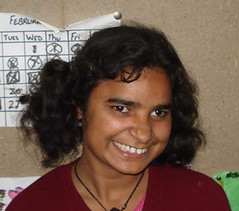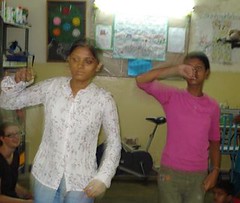by Anuradha Bakshi | Dec 15, 2007 | two indias
The gunning down of a young teenager by his peers last week has raised a host of questions in everyone’s mind, disturbing questions to say the least, but questions that need to be addressed as they concern the well being and future of our children.
One should not make the mistake of treating this as an isolated incident and try to find a convenient scapegoat: a careless parent or a careless school. And one should not compound the mistake by imputing this disturbing act to vague reasons such as violent Internet games or new money . This incident is endemic to what we have allowed ourselves to become and thus each one of us is responsible for the four bullets that were fired by tender hands on that fateful Tuesday. What happened that day is a reflection of what our society has mutated to in the recent past.
In our rush to acquire a new identity defined by malls and powerful cars, by overt luxury and opulence we have destroyed the very fabric of our society. In our haste to embrace alien ways, we simply sacrificed the values that held us together for thousands of years.
One of the many solutions proffered while discussing the Gurgaon killing was the importance of widening the scope of education ands making it more meaningful. A glance at today’s education pattern in Delhi, India’s capital city is sufficient to make us aware of the fact that something is terribly wrong. In the past few years one has seen on the one hand the degradation of the state run school system where children in class IV or V can barely recognise their alphabets, while at the other hand there has been a mushrooming of luxury schools that look more like five star resorts than places of learning. Even education that should be a level playing field today reflects a divided and fractured society.
My mind goes back to the very beginning of pwhy when we set out to define education in a broad sense and adopted the Four Pillars of Education of the UNESCO Delors Commission. Learning for Jacques Delors did not stop at knowledge but extended well beyond: learning to know, to do, to be and to live together. I must confess that somewhere down the way we too forgot the importance of this multi-pronged approach.
Learning to live together has to become an integral part of our education system where children are taught to respect each other and celebrate differences and learning to live with others can only happen when schools look like schools and not like dilapidated structures or luxurious edifices, almost as if they were replicating the lives of the children they teach. Children are far more resilient than we want to believe and can adapt to almost anything. Schools should be a place where children learn to cope with life in all its manifestations and hence reflect a middle path approach.
One has to take a serious and honest look at education as it stands today and take the needed measures to reform it drastically. Only then will true healing begin
by Anuradha Bakshi | Dec 13, 2007 | two indias
The gunning down of a 14 year old by his classmates in an upscale school in the suburbs of Delhi has shocked everyone. What seemed to be something that happened elsewhere, in other lands is now on our doorstep.
The past two days have seen a plethora of reactions from people of all walks of life trying to explain why this incident happened. From lax gun laws, to lax parenting; from violence on TV shows to violence in children, the causes are many and need to addressed. But what was at the same time sad and frightening was the sometimes furtive but often unconcealed references to the social background of the children. The greatest tragedy of the Gurgaon shooting is undoubtedly the fact that the children in question belonged to the other side of the fence, to the other India or rather as a commentator said to the third India that no one has seen coming: an India that is now claiming its right to everything that till late had never been theirs.
That rural parents should want the best for their children is to be lauded; that upscale schools are recognising this reality and becoming inclusive should also be hailed. It is definitely a step in the right direction. One should not make the fatal mistake of looking at this terrible tragedy as a social one, as one that occurred because the children in question belonged to a certain class of society. Children from so called good homes have also slipped and made horrific mistakes.
My blood ran cold when a parent interviewed by a TV channel stated that rural kids could not adapt to convent schools. This is a mistake we should not and cannot make as unlike what we knew as the other India is very different from the new India that is emerging and assuming power.
The reality is that in today’s day and age money has taken the place once held by values. This a phenomena that transcends social barriers and is becoming a hydra-headed monster that will be difficult to contain.
The Gurgaon shooting is a wake up call in more ways than one. We must look at it in larger perspective and take remedial measures. What is needed is to have the courage to assume responsibility rather than pass the buck or simply forget it thinking that it cannot happen to us. And above all one has to ensure that this incident does not close doors for children seeking a better morrow.
by Anuradha Bakshi | Oct 29, 2007 | two indias
Sunday October 28th 2007, saw the enfolding of a another tale of two Indias in the streets of its capital city: thousands of well shod and well clad beautiful people ran a well sponsored half marathon in one part of the city, while 25 000 landless and often barefoot protesters silently entered another part of the city to demand their usurped land rights. They had no sponsors. They had simply donated one fistful of food grain and one rupee a day for the last three years.
Their march had begun on October 2nd, 350 kilometers away a stunning reminder of Gandhian ways in a new age avatar. Dignified and silent and yet so vibrant. Most of them tribal and dalits displaced by big development projects and given no alternative source of livelihood.
Whereas the marathon ended with winners and prize money, their fight has just begun as they intend to stay on till they are heard. What disturbed me this morning as I opened the newspaper was a deafening silence: whereas the marathon was covered in large headlines and full pages, this silent and dignified march was strangely absent.
Is this not another instance of the reality of two Indias?

by Anuradha Bakshi | Aug 30, 2007 | two indias

A report based on government data for the period 1994 – 2004 reveals the startling fact that over 800 million people or 75% of India’s population lives on a per capita income of less than 2o rs a day. The report goes on to say that a person whose consumption is less than rs 9, is below the poverty line, whereas Rs 13 makes him above that line.
The report is startling and even if it not 100% correct, it still raises many questions that need to be asked. We have heard of India shining, India poised, India on the threshold of becoming a super power and yet if we peruse the statistics of this report we see that India shines only for under 30% of its population.
In recent days I have heard some other startling figures that are also a reality: a 4 bedroom flat rented at 500 000 rs a month, a bottle of vintage champagne sold at rs 50 000 a piece in an upmarket eatery which is the actual mecca for the young rich of our capital and where a few such bottles are sold every night, and even a never to be advertised gourmet menu in a luxury hotel at a mind boggling price. You just have to flip the pages of any women’s magazine to see shoes and bags at 50 000 or more, and cosmetics that would burn a hole in your pocket, not to mention the cryptic price on request appended to many a luxury items.
The new, or rather suddenly rediscovered urban laws that are being applied with new found vigour will result in swelling the quoted 70% as most of these hit the livelihood of the poor: street food, small shops etc. Slum relocation undertaken without viable options and with the aim to make our capital city fit for consumption for the forthcoming sports show will have a similar effect.
The writing is on the wall but no one is willing to look at it. No self respecting nation, let alone a democracy, can arrogate itself the right to be called shining if more than 50% of its population barely eeks out a living. As I have often held there are two Indias: one that maybe shines and another that lives in ever increasing darkness.

by Anuradha Bakshi | Aug 23, 2007 | sealing, two indias

Champa may soon lose her home, one she has lived in since she was a very tiny girl. Champa lives at the ill famed transit camp with her mother who works in homes as a maid.
For the past few days Champa has not been able to comprehend why her mom has not gone to work. She normally leaves at 6 am, even locking Champa out. Champa cannot comprehend why everyone is shouting and cluttering the street. All this is disturbing and unsettling.
What Champa is witnessing from the confines of her simple mind is actually a plight that is befalling many residents in India’s capital city. The transit camp, as its name implies, is land that was given to slum dwellers two decades ago, when they were moved out of an upmarket location. At that time one wonders whether anyone understood what transit meant, or whether the authorities gave them a specified time frame. Over the years this camp turned into a vibrant and crowded colony, with multi floored structures where rooms were given out on rent. Greed and false promises of regularisation made by local politicians looking for votes lent a sense of false permanence and some original allottees even sold out their plots.
For the past year or so this long forgotten colony once at the edge of the city, came back into the limelight as authorities rediscovered the meaning of transit. Since many an attempt to seal or raise it have been made, each met with the understandable anger of the residents aptly supported by some local politico or the other resulting in the usual drama of protests and arrests.
But this time for reasons yet unknown it seems that this colony will be destroyed and thousands of men,women and children will yet again be rendered homeless notwithstanding their ration card or voter’s ID that proudly displays a transit camp address. This time it seems that the game is over and no amount of palm greasing or political support will help.
The transit camp issue brings to light one of the worst ailment that plague our social fabric. Whereas we all know that the rule of law must prevail, laws are never respected at the initial moment but allowed to be circumvented endlessly till all avenues are explored regardless of the human factor but propelled by the greed of one and all. As a society we have to be made to understand that laws need to be respected from the time they are promulgated.
Champa’s case is poignant. If her home is relocated she loses not only her home, but also the safety and protection of pwhy where she spends the only happy moments of a very sad life.

by Anuradha Bakshi | Aug 16, 2007 | two indias
 R and S are hearing impaired. R is 19 and S 14. They are both students of our special section and are real live wires. In the last years they have learnt many things from tailoring to cooking, from paper craft to weaving. R is a talented artist and S can cut and stitch a mean suit. They have evolved their won ways of communicating and have opinions on every and any thing. And yes they can even dance to the latest Bollywood number not missing a beat. R has finished training as a beautician and has a part time job at the local beauty parlour. S will also get the same training soon and join the ranks of the gainfully employed. Both are happy young girls who have taken life’s challenges in their stride.
R and S are hearing impaired. R is 19 and S 14. They are both students of our special section and are real live wires. In the last years they have learnt many things from tailoring to cooking, from paper craft to weaving. R is a talented artist and S can cut and stitch a mean suit. They have evolved their won ways of communicating and have opinions on every and any thing. And yes they can even dance to the latest Bollywood number not missing a beat. R has finished training as a beautician and has a part time job at the local beauty parlour. S will also get the same training soon and join the ranks of the gainfully employed. Both are happy young girls who have taken life’s challenges in their stride.
They both belong to poor families. S’s father is a small time tailor and R’s father keeps poor health and thus does not work much. Like for all girls in India, their parents hope to get them married one day.
A few months ago some visitors from Europe came to pwhy and were touched by these tow vibrant young ladies. They wanted to know whether there was any way in which their hearing could be restored. We had of course explored all ways when they first came to us and had been told that only a cochlear implant could help the, the boggling 1 million rupees that such an implant cost put an end to our efforts.
Last week I got a mail saying that there could be a possibility of sponsoring the implants and seeking added information. True cochlear implants are done In India at the cost of 6 to 9 hundred thousand rupees. there is an added cost of 100 000 Rs for the operation and one has speech therapy for at least two years, regular implant programming and life long annual follow ups. The operation is daunting for any one and more so for simple families who barely survive let alone live. The likelihood of these two young ladies being married in another city or village is real and that would put an end to follow ups and complex programming. The implant could become an impediment rather than an asset.
As we sat with the teachers and special educators wondering what to do, we realised that both R and S were comfortable in their silent world. They had evolved their own ways of dealing with life’s realities. They somehow were far more independent than many other young girls their age who hear but have not been educated. They have various skills and hence many avenues are open to them. A complex surgery may turn out to be a hindrance and destabilise them completely. The whopping amount spent would ultimately bring more trouble than joy.
At times like these, the existence of two Indias becomes painfully real and puts us in a disturbing dilemma. To heart or not to hear, that is the question.






